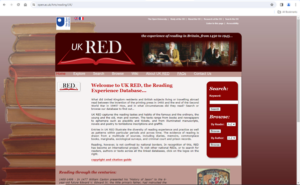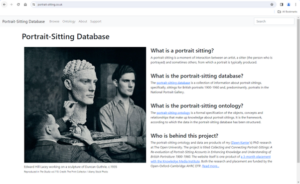by Dawn Kanter
It’s a pleasure to have joined the University of Reading last month as Digital Humanities (DH) Officer. I’ll be working as part of the Digital Humanities Hub, which combines expertise in different teams across the University in order to support research that falls within the broad and dynamic discipline of DH.
The first DH project that I became interested in – or at least, the first I recognised as DH – was the UK Reading Experience Database (UK RED). The UK RED collates records of experiences of reading in Britain or by British subjects between 1450 and 1945. It includes information both about the experiences themselves (for example, who was reading) and about our evidence of them (for example, who recorded the reading experience). The former (information about reading) can be understood as data and the latter (information about information about reading) as metadata. I was fascinated by this systematic approach to something as complex and subjective as the experience of reading, not least because it has enabled researchers to examine, for example, how reading has changed over time.

At the time that I discovered the UK RED, I was employed at the National Portrait Gallery (NPG), digitising textual information about portraits so that it could be served online. In the course of doing so, I discovered several accounts of portrait sittings: the moments of interaction between artists, sitters and sometimes others, from which portraits are typically produced. The accounts interested me because they gave insight into the social dimension of portrait practice. They spoke of the circumstances which prompted portrait production, the conversations that took place during sittings, and the thoughts and feelings of participants. However, this information could not be searched, analysed or compared systematically. Whereas I could search the gallery’s collections database for all paintings, I could not retrieve all portraits produced between friends, for example. (This focus on tangible cultural objects as opposed to intangible cultural events is not unique to the NPG, but rather characteristic of digital approaches to cultural heritage more broadly.)
‘Elizabeth [Garrett Anderson] wished to be painted in her M.D. gown. [John Singer] Sargent begged for some jewellery, so she added a pearl necklace costing sixpence.’ Biography of Elizabeth Garrett Anderson by Jo Manton (1965)
‘I [Alfred Hitchcock] sold [a script] to … [Michael] Balcon, for five hundred pounds. But I was so ashamed of the profit that I had the sculptor Jacob Epstein do a bust of Balcon with the money.’ Interview with Alfred Hitchcock by Francois Truffaunt (1966)
‘During our time together we discussed … music … I [Frank Salisbury] said my favourite piece … was Handel’s “Largo”. He [Henry Wood] said at once, “It is mine also.” [The] next day he brought his [sheet] music, and … I painted it into the portrait.’ Autobiography of Frank Salisbury (1953)
Excerpts from accounts of sittings for portraits of Elizabeth Garrett Anderson, Michael Balcon and Henry Wood.
I went on to devise a PhD research project, which explored how the methodology of the UK RED (and other, albeit exceptional, experience databases such as the Listening Experience Database) could be applied to address the portrait-sitting experience. As part of the research, I considered such questions as: What constitutes portrait-sitting data? What would be the value of such data? What could it tell us about portraiture and portrait practice? Specifically, I examined a period in the history of British art (1900-1960) in which there was supposedly a dramatic shift in portrait practice and function – from commissioned portraiture that affirmed the sitter’s position in society, to artists’ experiments in shape, space and colour that happen to take people as subjects. I used a database of portrait sittings to test – and present an alternative to – this narrative, to support new groupings of portraits, and to propose a new periodisation of portraiture. (Links to the forthcoming thesis and other related resources appear here.)

One thing that I particularly enjoyed about this research was the capacity of digital and computational approaches to surprise me and to suggest new research questions. For example, I was surprised by how many portrait sittings involved exchanges of personal gifts. This led me to question the significance of such gifts and whether they were used, alongside portraits, in other periods. More generally, I am excited by what comes from combining the order and process of computing with the ambiguity and often-hidden complexity of humanities ‘data’ – and by the question of whether these disciplines are, in fact, so different and distinct. I look forward to exploring these matters further in the course of my role as Digital Humanities Officer, and to working with experienced colleagues across departments to support research in this field.
